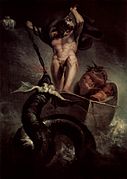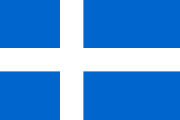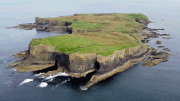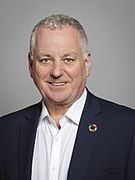The Scottish Islands Portal
Welcome! — Fàilte! — Walcome!

Scotland has around 900 offshore islands, most of which are to be found in four main groups: Shetland, Orkney, and the Hebrides, sub-divided into the Inner Hebrides and Outer Hebrides. There are also clusters of islands in the Firth of Clyde, Firth of Forth, and Solway Firth, and numerous small islands within the many bodies of fresh water in Scotland including Loch Lomond and Loch Maree. The largest island is Lewis and Harris which extends to 2,179 square kilometres, and there are a further 200 islands which are greater than 40 hectares in area. Of the remainder, several such as Staffa and the Flannan Isles are well known despite their small size. Some 94 Scottish islands are permanently inhabited, of which 89 are offshore islands. Between 2001 and 2011 Scottish island populations as a whole grew by 4% to 103,702.
The geology and geomorphology of the islands is varied. Some, such as Skye and Mull, are mountainous, while others like Tiree and Sanday are relatively low lying. Many have bedrock made from ancient Archaean Lewisian Gneiss which was formed 3 billion years ago; Shapinsay and other Orkney islands are formed from Old Red Sandstone, which is 400 million years old; and others such as Rùm from more recent Tertiary volcanoes. Many of the islands are swept by strong tides, and the Corryvreckan tide race between Scarba and Jura is one of the largest whirlpools in the world. Other strong tides are to be found in the Pentland Firth between mainland Scotland and Orkney, and another example is the "Grey Dog" between Scarba and Lunga. (More on Scottish islands...)
Selected picture
Selected island group
Shetland, also called the Shetland Islands, is an archipelago in Scotland lying between Orkney, the Faroe Islands, and Norway. It is the northernmost region of the United Kingdom.
The islands lie about 80 km (50 mi) to the northeast of Orkney, 170 km (110 mi) from mainland Scotland and 220 km (140 mi) west of Norway. They form part of the border between the Atlantic Ocean to the west and the North Sea to the east. Their total area is 1,466 km2 (566 sq mi), and the population totalled 22,920 in 2019. The islands comprise the Shetland constituency of the Scottish Parliament. The local authority, the Shetland Islands Council, is one of the 32 council areas of Scotland. The islands' administrative centre, largest settlement and only burgh is Lerwick, which has been the capital of Shetland since 1708, before which time the capital was Scalloway.
The archipelago has an oceanic climate, complex geology, rugged coastline, and many low, rolling hills. The largest island, known as "the Mainland", has an area of 967 km2 (373 sq mi), and is the fifth-largest island in the British Isles. It is one of 16 inhabited islands in Shetland.
Humans have lived in Shetland since the Mesolithic period. Picts are known to have been the original inhabitants of the islands, before the Norse conquest and subsequent colonisation in the Early Middle Ages. During the 10th to 15th centuries, the islands formed part of the Kingdom of Norway until they were annexed into the Kingdom of Scotland due to a royal dispute involving the payment of a dowry. In 1707, when Scotland and England united to form the Kingdom of Great Britain, trade between Shetland and continental Northern Europe decreased. The discovery of North Sea oil in the 1970s significantly boosted Shetland's economy, employment and public-sector revenues. Fishing has always been an important part of the islands' economy. (Full article...)
News
- 12 February: The BiFab construction yard at Arnish near Stornoway, Isle of Lewis, is purchased by InfraStrata.
- 11 February: Wild fires occur in Benbecula; and at Achmore and Sildinish in the Isle of Lewis; Horsaclete in Harris; Brevig in Barra; and Eubhal in North Uist.
- 19 January: Barra and Vatersay are put under tier-4 restrictions after an outbreak of Covid-19.
- 18 January: The Shetland Space Centre submits plans for a spaceport on Unst (proposed site pictured), Shetland, including three rocket launch pads.
- 8 January: Distilleries in Orkney and South Uist receive government grants to research ways of reducing their CO2 emissions.
- 4 January: After the UK leaves the European Union, the Northern Celt, an Irish fishing boat based out of Greencastle, County Donegal, is ordered to leave the 12-nautical-mile zone around Rockall by officers of Marine Scotland.
- 1 January: A total of 72 cases of Covid-19 are recorded in an ongoing outbreak in Shetland.
- 9 December: A review by a committee of MSPs into the commissioning and building of two new dual-fuel Caledonian MacBrayne ferries, MV Glen Sannox and "hull 802", criticises CMAL, Transport Scotland and the Scottish government, as well as the ship builders, Ferguson Marine.
- 3 December: North-east Lewis, Sea of the Hebrides and Shiant East Bank are designated Marine Protected Areas, while East Mainland Coast Shetland, Sound of Gigha, Coll and Tiree, Rùm, the west coast of the Outer Hebrides, and the waters off St Kilda and Foula are designated Special Protection Areas.
- 30 November: Michael Russell, MSP for Argyll and Bute, and David Stewart and John Finnie, MSPs for the Highlands and Islands region, will stand down at the 2021 election.
- 17 November: Phytophthora ramorum-infected larch trees in Arran are to be felled over a 543-acre area, to prevent the fungus-like pathogen from spreading.
- 4 November: The Scottish Wildlife Trust objects to a proposed salmon farm in the Marine Protected Area of Wester Ross, near Horse Island, Summer Isles, because of the potential impact on kelp forests and maerl beds.
Selected fauna
The Shetland Sheepdog, also known as the Sheltie, is a breed of herding dog that originated in the Shetland Islands of Scotland. It was formally recognized by The Kennel Club in 1909. It was originally called the Shetland Collie, but this caused controversy amongst Rough Collie breeders of the time, so the name was changed. It is a small dog, clever, vocal, willing to please, and trustworthy.
Like the Shetland pony, Shetland cattle and the Shetland sheep, the Shetland Sheepdog is a hardy but diminutive breed developed to thrive amidst the harsh and meagre conditions of its native islands. While the Shetland still excels at herding, today it is often raised as a working dog and/or family pet.
The Shetland's origins are obscure, but it is not a direct descendant of the Rough Collie, which it largely resembles. Rather, the Shetland is a descendant of small specimens of the Scottish Collie and the King Charles Spaniel. They were originally a small mixed-breed dog, often only about 20 to 30 centimetres (8 to 12 inches) in height at the shoulder, and it is thought that the original Shetland herding dogs were of the Spitz type, and were crossed with Collies from mainland Britain. In the early 20th century, James Loggie added a small Rough Collie to the breeding stock, and helped establish the breed that would become the modern Shetland Sheepdog. (Full article...)
Selected history & culture article

The stoor worm, or Mester Stoor Worm, was a gigantic evil sea serpent of Orcadian folklore, capable of contaminating plants and destroying animals and humans with its putrid breath. It is probably an Orkney variant of the Norse Jörmungandr, also known as the Midgard Serpent, or world serpent, and has been described as a sea dragon.
The king of one country threatened by the beast's arrival was advised to offer it a weekly sacrifice of seven virgins. In desperation, the king eventually issued a proclamation offering his kingdom, his daughter's hand in marriage, and a magic sword to anyone who could destroy the monster. Assipattle, the youngest son of a local farmer, defeated the creature; as it died its teeth fell out to become the islands of Orkney, Shetland and the Faroes, and its body became Iceland.
Similarities between Assipatle's defeat of the monster and other dragon-slayer tales, including Herakles' destruction of a sea monster to save Hesione, have been noted by several authors. It has been suggested that tales of this genre evolved during a period of enlightenment when human sacrifices to bestial divinities were beginning to be suppressed. (Full article...)
Selected island
Staffa (Scottish Gaelic: Stafa, pronounced [ˈs̪t̪afa], from the Old Norse for stave or pillar island) is an island of the Inner Hebrides in Argyll and Bute, Scotland. The Vikings gave it this name as its columnar basalt reminded them of their houses, which were built from vertically placed tree-logs.
Staffa lies about 10 kilometres (6 miles) west of the Isle of Mull; its area is 33 hectares (82 acres) and the highest point is 42 metres (138 feet) above sea level.
The island came to prominence in the late 18th century after a visit by Sir Joseph Banks. He and his fellow-travellers extolled the natural beauty of the basalt columns in general and of the island's main sea cavern, which Banks renamed 'Fingal's Cave'. Their visit was followed by those of many other prominent personalities throughout the next two centuries, including Queen Victoria and Felix Mendelssohn. The latter's Hebrides Overture brought further fame to the island, which was by then uninhabited. It is now in the care of the National Trust for Scotland. (Full article...)
Did you know?
- ... that Symbister House (pictured) in Symbister, on the island of Whalsay in Shetland Islands, is reputed to be haunted by a sailor who was murdered by the gardener during a game of cards?
- ...that the Hebrides Overture, also known as Fingal's Cave and composed by Mendelssohn, was inspired by the famous cave off the coast of Scotland?
- ... that Old Norse poems attributed to Torf-Einarr describe his defeat of Hálfdan Longlegs?
- ...that several of the Orkney islands' highest points are named "Ward Hill" due to the many old warning beacons in the area?
Selected portrait
Selected geography article

Sabhal Mòr Ostaig ([ˌs̪ɔɫ̪ ˌmoɾ ˈɔs̪t̪ɪkʲ]) (Great Barn of Ostaig) is a public higher education college situated in the Sleat peninsula in the south of the Isle of Skye, Scotland with an associate campus at Bowmore on the island of Islay. Sabhal Mòr is an independent Academic Partner in the federal University of the Highlands and Islands. Its sole medium of instruction on degree courses is Scottish Gaelic.
Since its foundation in 1973 Sabhal Mòr Ostaig has played a crucial role in the linguistic and cultural renaissance of Gaelic in Scotland. The college enjoys an international reputation for the study of the history and literature of the Gàidhealtachd, past and present; for research into political, educational, and community aspects of minority language maintenance and revitalisation; and for its engagement with Gaelic creative arts, as well as with broadcast and online media.
Sabhal Mòr's research base has been further strengthened to take in sociolinguistics, through the Soillse initiative; corpus planning and historical lexicography, through the Stòrdata Nàiseanta na Gàidhlig/Gaelic Terminology Database and the Faclair na Gàidhlig/Dictionary of Scottish Gaelic projects; and toponomy, through the Ainmean-Àite na h-Alba/Gaelic Place-Names of Scotland advisory partnership, all based at the college. Research capacity is underpinned by the Sabhal Mòr Ostaig Library with its internationally important collections of material related to Gaelic and to the Highlands, and further complemented by the proximity of two major Highland archives: those of MacDonald of Sleat in the Museum of the Isles by Armadale Castle, and the MacLeod papers in Dunvegan Castle. Through academic collaboration and student exchanges, the college maintains close links with partner institutions in Scotland, Ireland, Wales, and Nova Scotia.
With established residencies for writers, artists, musicians, and dramatists; its prominent degree courses in media and traditional music; its hosting of the national folklore digitisation project Tobar an Dualchais/Kist o Riches; and Fàs, its £8-million centre for creative industries, Sabhal Mòr fulfils an important cultural remit both in the Highlands and in Scotland more generally. (Full article...)
Selected biography
Jack Wilson McConnell, Baron McConnell of Glenscorrodale, PC (born 30 June 1960) is a Scottish politician who served as First Minister of Scotland and Leader of the Labour Party in Scotland from 2001 to 2007. McConnell served as the Minister for Finance from 1999 to 2000 and Minister for Education, Europe and External Affairs from 2000 to 2001. He has been a Labour life peer in the House of Lords since 2010 and previously served as a Member of the Scottish Parliament (MSP) for Motherwell and Wishaw from 1999 to 2011.
Born in Irvine, Ayrshire, McConnell studied at the University of Stirling and worked as a mathematics teacher at Lornshill Academy. His political career began when he was elected to the Stirling District Council, while he was still teaching. He served as a member of the Scottish Constitutional Convention, having campaigned in-favour for a Scottish Parliament in the 1997 devolution referendum. Elected to serve as an MSP for the Motherwell and Wishaw constituency in the 1999 Scottish Parliament election, McConnell was appointed Minister for Finance under the Donald Dewar government. After Dewar's death in 2000, he ran unsuccessfully for the leadership of the Labour Party in Scotland, having been defeated by Henry McLeish. McLeish appointed McConnell as Minister for Education, Europe and External Affairs.
In 2001, McLeish resigned in the aftermath of the Officegate scandal and McConnell was elected unopposed as the Scottish Labour leader. He was appointed First Minister on 22 November 2001, becoming the youngest office holder. As first minister, he implemented a ban on smoking in public places, signed a Co-operation Agreement with Malawi, and successfully bid for the 2014 Commonwealth Games to be hosted in Glasgow. In the 2007 Scottish Parliament election, the Labour Party in Scotland became the second largest party, with the SNP having one seat more. This therefore lead to McConnell losing office, becoming the first First Minister to have been defeated from office.
After losing office as first minister, McConnell sat as the Leader of the Opposition in Holyrood, until his resignation as leader. He sat as a backbencher and stood down as an MSP in the 2011 election. In 2010, McConnell became a member of the House of Lords of the United Kingdom. He made a commitment to continuing his work to tackle poverty in Africa and to develop the relationship between Scotland and Malawi. (Full article...)
Related portals
Selected panorama
Topics
Categories
The main category is Islands of Scotland, with subcategories

Things you can do
- Add new articles to the project by placing {{WPSI|class=|importance=}} on the talk page
- Add a link to the portal in the "See also" section of relevant articles with {{Portal|Scottish islands}}
- Take requested photographs or create requested pages, including Prehistoric Hebrides, Trialabreac, Dog Isle...
- Expand a Scottish Islands stub into a full article, adding images, citations, references and infoboxes; did you know that if you expand one 5x, you can nominate it for Did You Know?
- Improve one of the highest priority articles, including Mull, Bute, North & South Uist, Columba, Highland Clearances, Sorley MacLean, St Magnus Cathedral...
- Follow these hints to improve a B-class article and nominate it for Good Article

- Suggest articles, pictures, interesting facts, events and news to be featured here on the portal
Wikiproject
Associated Wikimedia
The following Wikimedia Foundation sister projects provide more on this subject:
-
 Commons
Commons
Free media repository -
 Wikibooks
Wikibooks
Free textbooks and manuals -
 Wikidata
Wikidata
Free knowledge base -
 Wikinews
Wikinews
Free-content news -
 Wikiquote
Wikiquote
Collection of quotations -
 Wikisource
Wikisource
Free-content library -
 Wikiversity
Wikiversity
Free learning tools -
 Wikivoyage
Wikivoyage
Free travel guide -
 Wiktionary
Wiktionary
Dictionary and thesaurus






































































